Humans have a lot of talents. Some of us can juggle, others can play the guitar, while others can juggle guitars (probably). Yet most of what we can do relies on our brains and hands. That means that there are a whole bunch of things we'll never be able to do, like tie ourselves in a knot, liquefy our bodies to squeeze through small spaces, or swallow a guitar (short of some horrifying juggling accident). Those kinds of talents are left to other animals, like the underwater critters here.
人们有很多才能。有人会杂耍,有人会弹吉他,还有人(可能)会用吉他玩杂耍。而我们所做的一切大部分依靠我们的大脑和双手。这也就意味着有很多事我们永远也做不了,比如把自己打成一个结,把身体融化后钻进细小的空间,或者吞掉一把吉他(某些令人震惊的杂耍除外)。这些才艺属于其它动物,比如下面这些水生动物。
10.Black Swallowers Eat Enormous Prey
10.黑色饕餮鱼捕杀大型猎物
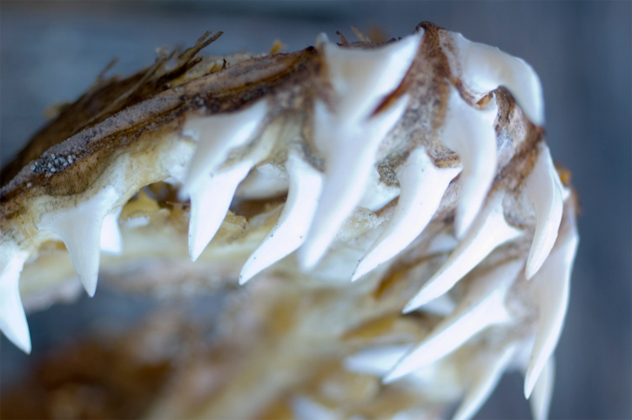
The horrifying black swallower has a talent that's given away by the huge sack of a stomach that dangles beneath its body. Chiasmodon niger has many of the features that make other deep sea fish frightening, like its bulging black eyes and abominable teeth. Yet it's the fish's ability to swallow its prey whole that makes it stand out. When the black swallower finds something it wants to munch on, it darts out, grabs hold, and inches its jaws over the victim until the entire prey is consumed.
黑色饕餮鱼长相很吓人,身体下面藏着一个巨大的胃,它们因此而具有一项特长。黑色叉齿鱼(Chiasmodon niger)有许多令其它深海鱼害怕的特征,如肿胀的黑色大眼和让人生厌的牙齿。然而这类鱼天生能一口吞掉整个猎物——在鱼类中"出类拔萃"。当黑色叉齿鱼发现了它想吃的东西,它会突然冲出来,一把抓住猎物,张开嘴一点一点吞噬猎物,直到把猎物全部吃掉。
It's not fussy about what it eats, and it can swallow animals twice its length and over 10 times its mass. Its stomach becomes so stretched that it ends up translucent, so you can see the swallower's latest meal being digested. And digestion takes so long that the swallower can't process some of its bigger targets before they start to decompose. This ends up filling the stomach with gas, and turns the fish into a balloon. It's these inflated black swallowers that end up floating to the surface, and they are the ones we find most often.
它们不挑食,能吞下比自己长两倍、大十倍的动物。它们的胃被撑得紧紧的,变得半透明,你能看见它们正在消化最近吃下去的东西。消化花的时间比较长,有些大家伙不腐烂,叉齿鱼还消化不了。所以它们的胃里充满了气体,身体变成了一个气球。这些膨胀的黑色饕餮鱼常常浮在水面上,也就是我们常常见到的那些。
9.Sea Slugs Can Perform Photosynthesis
9.海蛞蝓可以进行光合作用
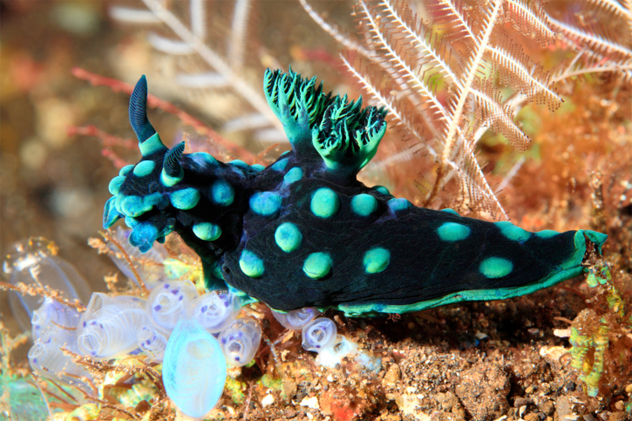
The sea slug Elysia chlorotica has an ability that's never been found in any other animal—it's able to photosynthesize its own food using sunlight. The ancestors of the slug lived on a diet of algae. The slug is able to steal the chloroplasts—organelles that perform photosynthesis—from the algae and incorporate them into its own cells. This gives the slug a distinctive green color, and they have been nicknamed "leaves that crawl."
绿叶海蛞蝓(Elysia chlorotica)有一种独一无二的能力——它能通过光合作用的方式为自己产生食物。蛞蝓的祖先以藻类为食。蛞蝓能盗用藻类的叶绿体——进行光合作用的细胞器官——并将它们融进自己的细胞中。这让蛞蝓呈现耀眼的绿色,还为它们得到一个昵称:"爬行的叶子"。
Even more surprisingly, the slug has stolen genes from the algae and is able to produce its own chloroplasts. Researchers found the genes even in juveniles that have never eaten. Yet in an added wrinkle, other scientists have found that the slugs are able to go for long periods of time in the dark without eating, and still survive quite happily. It suggests that the photosynthesis may not be the only key to their survival strategy. However much importance it has for the slug, it's a unique talent that no other animal can boast.
更让人惊讶的是,蛞蝓还盗用藻类的基因,能产生自己的叶绿体。研究人员在蛞蝓幼体体内发现了还没吃过的东西的基因。而在后来新设计的研究中,其它科学家发现蛞蝓能够在黑暗中长时间前行而不吃东西,而且活得很好。这表明光合作用可能不是它们唯一的生存战略。无论这对蛞蝓多么重要,这种特异功能是其它动物无法拥有的。
8.Planarians Heal Better Than Wolverine
8.涡虫的复原能力比狼獾还强
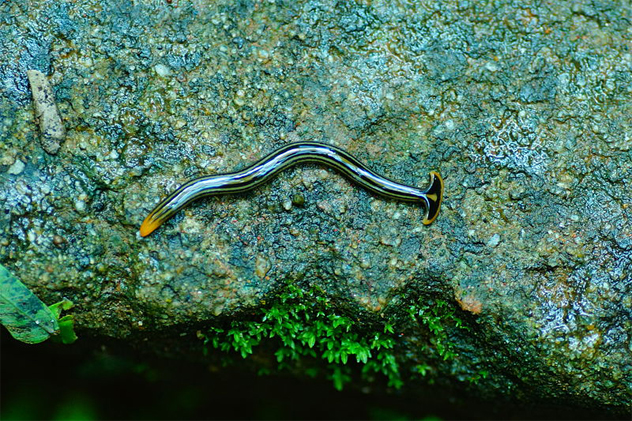
Planarians are a type of freshwater flatworm, which is an animal notable for its ability to regenerate. In fact, their regenerative abilities have given them two list-worthy talents. If you decapitate a flatworm, it will grow a new head. That's impressive by itself, but researchers have found that the new head gets the memories that developed before the old one was removed.
涡虫是一种淡水扁形动物,以其再生能力而出名。实际上,它们的再生能力赋予它们两种值得列在这里的才能。如果你切掉扁虫的头部,它会长出一个新的。这让人们印象深刻,但是研究员发现新长出的头具有切去旧头之前的记忆。
Scientists trained some planarians to tolerate light, which the worms normally avoid, then chopped off their heads. Two weeks later the worms had regenerated their missing noggins, but retained the learned tolerance to brightness. The researchers aren't certain how this happened. It may have been a change to the animal's DNA, or an unknown mechanism.Another team of researchers have found that a single cell has the ability to regrow an entire body. They bombarded a flatworm with radiation until its tissues were destroyed and its cells were no longer able to divide properly. They then injected a single cell from another adult, which was able to regrow every single part of the animal. This shows that adult stem cells in flatworms are able to turn into literally any body part, unlike adult human stem cells, which tend to be more limited.
科学家训练一些涡虫忍耐光线——涡虫一般躲避光线,然后切掉它们的头。两周以后,涡虫长出了失去的脑袋,但是保留了忍耐明亮的习惯。研究员不确定这是怎么发生的。这可能是因为动物的DNA发生了改变,或者未知的生理反应。另一组研究员发现,一个细胞有能力再生形成一个整体。它们用放射线辐射涡虫,破坏它的身体组织,让它的细胞不能再正常分裂。然后注入一个从另一个成年涡虫身上取下的单细胞——它能再生出所有部位。这基本表明,涡虫体内的成年干细胞能够转变成身体的任何一部分,不像人体干细胞那样有限。
7.Hagfish Tie Themselves In Knots
7.盲鳗把自己打成结
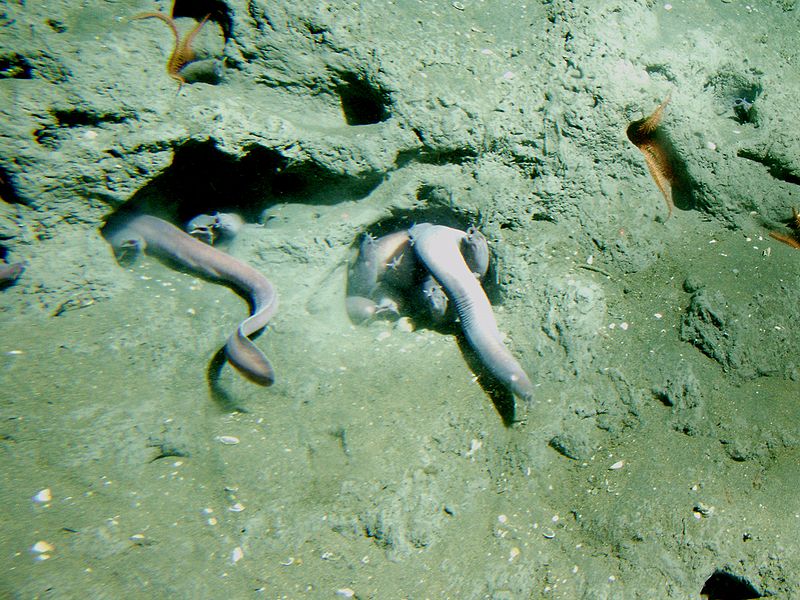
We've mentioned hagfish here before, but being around for 300 million years gives you plenty of time to develop more than one interesting trait. There's one talent possessed by these gooey not-really-fishes that we've never covered—hagfish are able to tie themselves in knots, an ability that comes in useful both in defense and when catching prey.
我们曾提到过盲鳗,但是大约3亿年的生存历史让它有足够的时间发展多项有趣的特点。这些又软又黏又并不真是鱼的动物,有一项我们未曾提到的才能——盲鳗能把自己打成结。这种能力在防御和捕猎时发挥作用。
When hagfish hunt, they do so by searching for fish burrows. When they find a fish hiding in a hole, they lunge face-first into the hole to pull it out. But sticking your head into a tunnel while your rear end flails around isn't the easiest way to pull out a fish that doesn't want to be eaten. To make it easier, the hagfish tie their rear end into a knot which is bigger than the hole. This gives them a perch around the top so they can pull themselves—and their lunch—back out. Hagfish have also turned this ability into an escape trick. If they're being held at one end, they'll tie the free end into a knot. They can then push the knot up their body, and when it reaches whatever's gripping the hagfish, the knot pushes against the predator and pulls the hagfish free.
盲鳗通过搜寻鱼儿的洞穴进行捕猎。当它们发现洞里藏着一条鱼时,它们脸朝洞穴冲进去将鱼拉出来。但是脑袋伸入地道、尾巴在外面摆动——要用这种方式抓出一条不想被吃掉的鱼并不容易。方便起见,盲鳗会将尾巴打成一个比洞口大的结。这样,它们在高处就有了位置上的优势,能够将自己——和午餐——拉出来。这个本事还是盲鳗逃生的技能。如果它们头尾一端被捉住了,它们会将另一端打成结,然后把这个疙瘩顺着身体移动。当结接近抓住盲鳗的动物时,这个结将对手推开,盲鳗就自由了。
6.Sea Cucumbers Liquefy Themselves
6.海参会融化
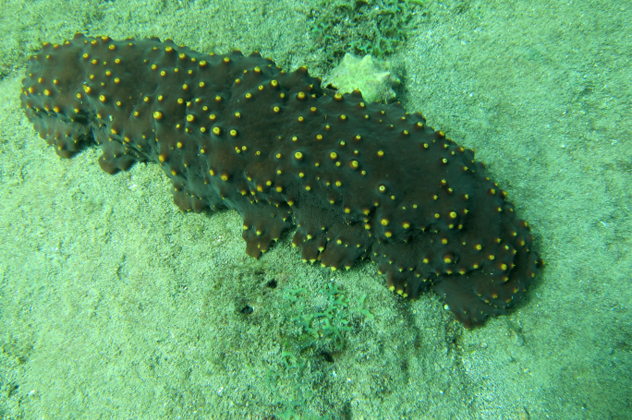
Sea cucumbers have a famous defense mechanism that we've told you about before. They eject their guts at predators, and regrow them later. Yet they have a second, equally unusual defense mechanism—they can liquefy themselves. Essentially, they unhook the bonds keeping their cells together and let themselves flow into (or out of) awkward spaces.
海参有一套出名的防御机制,我们之前提到过。它们将自己的内脏朝对手弹出去,之后再重新长出。它们还有第二套防御机制,同样不同寻常——它们能将自己融化掉。本质上,它们断开连接细胞的纽带,让自己流进(或流出)细小的缝隙。
When it's where it wants to get to, the sea cucumber can solidify itself again and become difficult to extract from a hiding place. This talent is so extreme that it's even possible for a cucumber to liquefy itself to death. It would turn purely into goo, and would simply flow through your fingers if you were holding it (at which point you would tell aquarium staff, "I swear I didn't do anything!").
如果这个地方是它想去的,海参能将自己再变坚固,这样就很难从藏身之地被拉出去。这项才能很极端,过分融化甚至能要了海参的小命。它会变得十分粘稠,如果你拿在手里,它会直接从你指缝间流走(你会对水族馆的工作人员说:"我发誓我什么都没干!")。
















